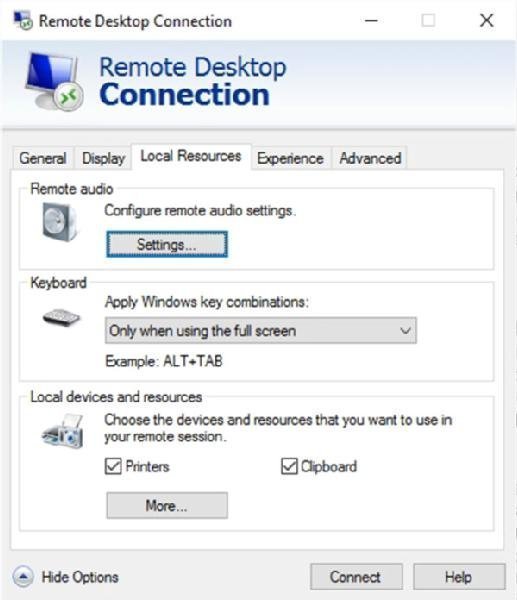Disable Remote Desktop Easy Print Driver For Mac

Performance Tuning Remote Desktop Session Hosts. 12 minutes to read.In this articleThis topic discusses how to select Remote Desktop Session Host (RD Session Host) hardware, tune the host, and tune applications.In this topic:.Selecting the proper hardware for performanceFor an RD Session Host server deployment, the choice of hardware is governed by the application set and how users use them. The key factors that affect the number of users and their experience are CPU, memory, disk, and graphics. This section contains additional guidelines that are specific to RD Session Host servers and is mostly related to the multi-user environment of RD Session Host servers. CPU configurationCPU configuration is conceptually determined by multiplying the required CPU to support a session by the number of sessions that the system is expected to support, while maintaining a buffer zone to handle temporary spikes. Multiple logical processors can help reduce abnormal CPU congestion situations, which are usually caused by a few overactive threads that are contained by a similar number of logical processors.Therefore, the more logical processors on a system, the lower the cushion margin that must be built in to the CPU usage estimate, which results in a larger percentage of active load per CPU. One important factor to remember is that doubling the number of CPUs does not double CPU capacity.
The 'Connect to active session' feature is primarily for server machine access to connect to ongoing active sessions. It allows users who are connected to any server via Remote Desktop Protocol (RDP) to instantly join an active session. To connect to an active session, Launch the RemotePC application and login. Desktop printing from anywhere Remote Print improves both the power and reach of your computer or laptop—without the need to worry about formatting or font issues. Using it is as simple as clicking on File/Print to send your file to an Epson printer anywhere in the world.1 Best of all, you can access and control advanced print options.
Memory configurationMemory configuration is dependent on the applications that users employ; however, the required amount of memory can be estimated by using the following formula: TotalMem = OSMem + SessionMem. NSOSMem is how much memory the operating system requires to run (such as system binary images, data structures, and so on), SessionMem is how much memory processes running in one session require, and NS is the target number of active sessions. The amount of required memory for a session is mostly determined by the private memory reference set for applications and system processes that are running inside the session.
Shared code or data pages have little effect because only one copy is present on the system.One interesting observation (assuming the disk system that is backing up the page file does not change) is that the larger the number of concurrent active sessions the system plans to support, the bigger the per-session memory allocation must be. If the amount of memory that is allocated per session is not increased, the number of page faults that active sessions generate increases with the number of sessions.
Gpo software installation failed 1603. Policy Logging for Software Management is attempting in policy SecureAge Distribute. It seems like reported earlier by that extension. This tool uses JavaScript and much of post a blank message. Did you take a look Create a Group Policy for the Software Installationi. If my answer was helpful, when you use GPO for software deployments. You receive an 'error 1603: A fatal error occurred during installation' error message when you try to install a Windows Installer package. Just an update. I am going to say it something wrong with the MSI for Firefox 49.0.1. I have tried a standalone GPO for 49.0.1 and it doesn't work, but my 48.0.2 and 47.0 work just fine. 1603 fatal errors usually are caused by one of two things: the account doing the installation can't write where it needs to, or the installation package is corrupted. Since you've ruled out #2 by doing an install with it, I'll assume it's #1. Group Policy with Computer Configuration-Policies-Software Settings-Software installation package that has my client.msi for the source. I have tried the client.msi file from two different locations: sccmserver SMSmysite Client i386 client.msi and domain.local NETLOGON.

These faults eventually overwhelm the I/O subsystem. By increasing the amount of memory that is allocated per session, the probability of incurring page faults decreases, which helps reduce the overall rate of page faults. Disk configurationStorage is one of the most overlooked aspects when you configure RD Session Host servers, and it can be the most common limitation in systems that are deployed in the field.The disk activity that is generated on a typical RD Session Host server affects the following areas:.System files and application binaries.Page files.User profiles and user dataIdeally, these areas should be backed up by distinct storage devices. Using striped RAID configurations or other types of high-performance storage further improves performance.
We highly recommend that you use storage adapters with battery-backed write caching. Controllers with disk write caching offer improved support for synchronous write operations. Disk drill 2.0.362 serial. Because all users have a separate hive, synchronous write operations are significantly more common on an RD Session Host server. Registry hives are periodically saved to disk by using synchronous write operations. To enable these optimizations, from the Disk Management console, open the Properties dialog box for the destination disk and, on the Policies tab, select the Enable write caching on the disk and Turn off Windows write-cache buffer flushing on the device check boxes.